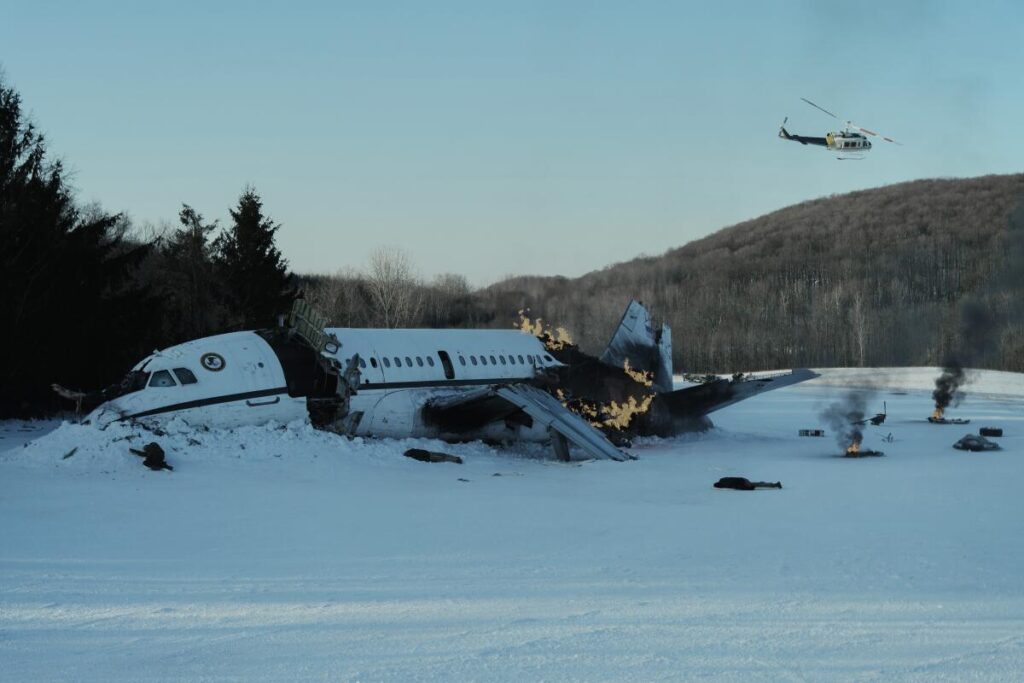In “The Last Frontier,” which premieres Friday on Apple TV+, a plane carrying federal prisoners goes down in the Alaskan wilderness outside a town where Frank Remnick (Jason Clarke) is the U.S. Marshal. Eighteen passengers survive, among them a sort of super-soldier we will come to know as Havlock (Dominic Cooper). Sad intelligence agent Sidney Scofield (Haley Bennett) is sent to the scene by her dodgy superior (American treasure Alfre Woodard).
I won’t go into it in depth, especially given the enormous number of reveals and reversals that make up the plot; pretty much everything not written here constitutes a spoiler. The production is excellent, with well-executed set pieces — the plane crash, a tug-of-war between a helicopter and a giant bus, a fight on a train, a fight on a dam. (I do have issues with the songs on the soundtrack, which tend to kill rather than enhance the mood.) The large cast, which includes Simone Kessell as Frank’s wife, Sarah — they have just about put a family trauma behind them when opportunities for new trauma arise — and Dallas Goldtooth, William Knifeman on “Reservation Dogs,” as Frank’s right hand, Hutch, is very good.
It’s as violent as you’d expect from a show that sets 18 desperate criminals loose upon the landscape, which you may consider an attraction or deal killer. (I don’t know you.) At 10 episodes, with a lot of plot to keep in order, it can be confusing — even the characters will say, “It’s complicated” or “It’s not that simple,” when asked to explain something — and some of the emotional arcs seem strange, especially when characters turn out to be not who they seem. Things get pretty nutty by the end, but all in all it’s an interesting ride.
But that’s not what I came here to discuss. I’d like to talk about snow.
There’s a lot of snow in “The Last Frontier.” The far-north climate brings weather into the picture, literally. Snow can be beautiful, or an obstacle. It can be a blanket, as in Eliot’s “Winter kept us warm, covering Earth in forgetful snow,” or a straitjacket, as in 2023’s “A Murder at the End of the World,” a Christie-esque murder mystery that trapped the suspects in an Icelandic luxury hotel. It’s part of the aesthetic and part of the action, which it can slow, or stop. It can be deadly, disorienting, as when a blizzard erases the landscape (see the first season of “Fargo”). And it requires the right clothes — mufflers, fur collars, wool caps, big boots, gloves — which communicate coziness even as they underscore the cold.
The snowy landscape in shows like “The Last Frontier” is part of the aesthetic and action.
(Apple)
Even when it doesn’t affect the plot directly, it’s the canvas the story is painted on, its whiteness of an intensity not otherwise seen on the screen, except in starship hallways. (It turns a moody blue after dark, magnifying the sense of mystery.) Growing up in Southern California — I didn’t see real snow until I was maybe 10? — I was trained by the movies and TV, where all Christmases are white if the budget allows, to understand its meaning.
It was enough that “The Last Frontier” was set in Alaska (filmed in Quebec and Alberta) to pique my interest, as it had been for “Alaska Daily,” a sadly short-lived 2022 ABC series with Hilary Swank and Secwépemc actor Grace Dove as reporters looking into overlooked cases of murdered and missing Indigenous women. This may go back to my affection for “Northern Exposure” (set in Alaska, filmed in Washington state), with its storybook town and colorful characters, most of whom came from somewhere else, with Rob Morrow’s New York doctor the fish out of water; “Men in Trees” (filmed in British Columbia, set in Alaska) sent Anne Heche’s New York relationship coach down a similar trail. “Lilyhammer,” another favorite and the first “exclusive” Netflix series, found Steven Van Zandt as an American mobster in witness protection in a Norwegian small town; there was a ton of snow in that show.
It serves the fantastic and supernatural as well. The polar episodes of “His Dark Materials” and “Monarch: Legacy of Monsters,” the icebound sailing ships of “The Terror” live large in my mind; and there’s no denying the spooky, claustrophobic power of “Night Country,” the fourth season of “True Detective,” which begins on the night of the last sunset for six months, its fictional town an oasis of light in a desert of black. In another key, “North of North,” another remote small town comedy, set in Canada’s northernmost territory among the Indigenous Inuit people is one of my best-loved shows of 2025.
But the allure of the north is nothing new. Jack London’s Yukon-set “White Fang” and “The Call of the Wild” — which became an Animal Planet series for a season in 2000 — entranced readers back around the turn of the 19th century and are still being read today.
Of course, any setting can be exotic if it’s unfamiliar. (And invisible if it’s not, or annoying — if snow is a thing you have to shovel off your walk, its charm evaporates.) Every environment suggests or shapes the stories that are set there; even were the plots identical, a mystery set in Amarillo, for example, would play differently than one set in Duluth or Lafayette.
I’ll take Alaska.
